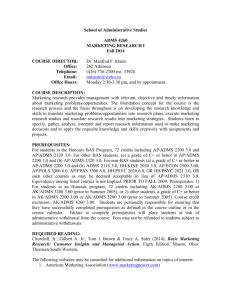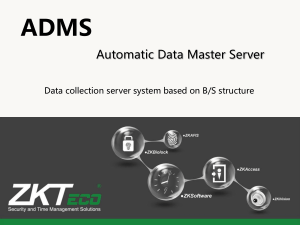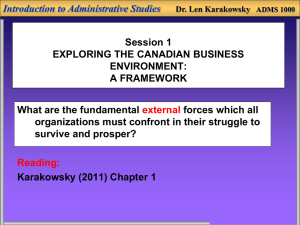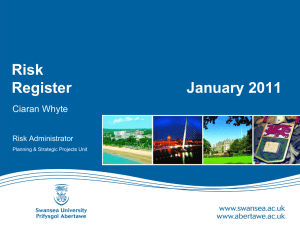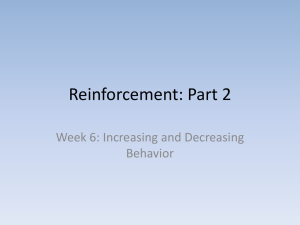3703_bcp_lecture_7_awaren
advertisement
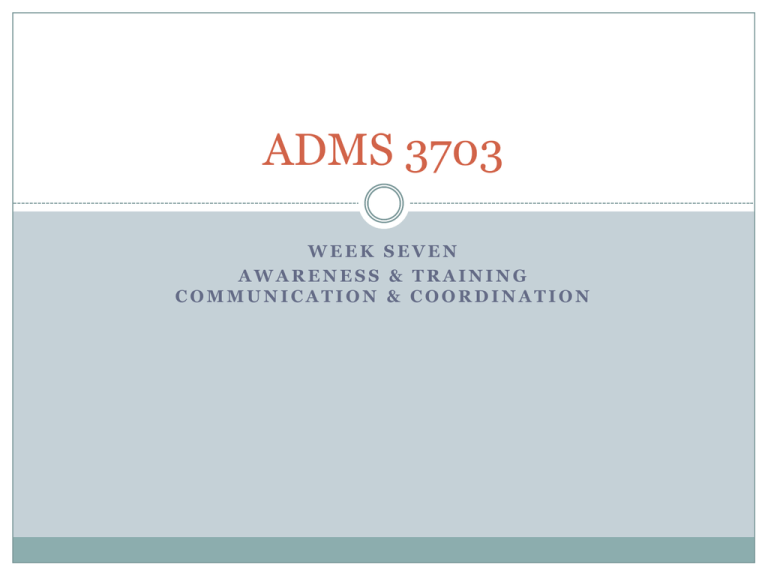
ADMS 3703 WEEK SEVEN AWARENESS & TRAINING COMMUNICATION & COORDINATION Awareness & Training 2 Plans are no good if they are secret Different parts of the organization need different information Start at the top Work down through the whole organization. ADMS 3703 Week 7 Strategic Plans 3 Senior Management Already have Crisis Management What’s the difference? Roles in Recovery and Continuity ADMS 3703 Week 7 Tactical Plans 4 Tactical Plans must be understood by Management Tactical Managers need to understand Priorities Need to understand Recovery Strategies Need to understand their Plans ADMS 3703 Week 7 Operational Plans 5 Operations Plans must be Executed Staff need to know where to go What to do What the priorities are for their desk Priorities can change ADMS 3703 Week 7 BCI Operational Response 6 Tactical level plans will rapidly become unwieldy if all recovery procedures are included in a single document. When this becomes the case, the response and recovery plans of each business unit should be made into one or more separate operational plans that become the responsibility of the business unit to which they relate. ADMS 3703 Week 7 BCO Coordination 7 Communication & Coordination is ‘baked in’ Business Units develop coordination through daily operations Coordination becomes organic to the organization BIA Recovery Strategies Planning Exercising ADMS 3703 Week 7 DRI 8 SUBJECT AREA 7 - AWARENESS and TRAINING PROGRAMMES Prepare a program to establish and maintain corporate awareness that Business Continuity Management (BCM) is a part of normal business management and to develop and enhance the skills required to create and implement BCM. ADMS 3703 Week 7 DRI: THE PROFESSIONAL’S ROLE IS TO: 9 A. A.1 Establish Objectives and Components of Corporate BCM Awareness and Training Program A.2 Identify Functional Awareness & Training Requirements A. 3 Develop Awareness & Training Methodology A. 4 Acquire or Develop Awareness & Training Tools A.5 Identify External Awareness & Training Opportunities A.6 Identify structure and delivery mechanisms for training ADMS 3703 Week 7 DRI 10 B.1. Establish Objectives and Components of Corporate BCM Awareness & Training Program B.1.a. Obtain support of Senior Management. (i) Secure adequate budget. (ii) Define program management approach and implementation timeframes. B.1.b. Obtain Commitment from Managers and Operational Staff who will implement BCM. B.1.c. Align BCM to business priorities. B.1.d. Define the desired level of awareness based on responsibilities. ADMS 3703 Week 7 DRI - Identify Functional Awareness & Training Requirements 11 B.2 B.2.a. Awareness assessment necessary to assess current levels of awareness against desired levels. (i) Assess awareness gaps. (ii) Identify and document the BCM roles and responsibilities. (iii) Define measures for desired levels of awareness. (iv) Re-assess periodically B.2.b. Identify and prioritize internal target groups. (i) Management (ii) Team members (iii) Key stakeholders (iv) New employee orientation (v) Employee refresher program. ADMS 3703 Week 7 DRI - Identify Functional Awareness & Training Requirements 12 B.2.c. Identify and prioritize external target groups (i) Key stakeholders (ii) Third parties B.2.d. General Staff requirements may include: (i) Initial notification (ii) Responding to specific threats or events. (iii) What to do when evacuated from the work site. (iv) Knowledge of recovery plans. B.2.e. Identify Training Structure (i) Define Training roles and responsibilities. (ii) Prioritize teaching points defining the BCM message to be assimilated. (iii) Select order and delivery methods. (iv) Re-Assess awareness levels. ADMS 3703 Week 7 DRI - Develop Awareness & Training Methodology 13 B. 3 B.3.a. Conduct Awareness assessment (i) Identify documentation to be used - Corporate policy statements - Incident Management Response Reports - Previous tests and exercise results - Business metrics (ii) Distribute awareness surveys. B.3.b. Gain feedback through focus groups B.3.c. Initiate plan to address awareness gaps B.3.d. Identify trends and new developments ADMS 3703 Week 7 DRI - Develop Awareness & Training Methodology 14 B.3.e. Develop program to target audience based on recommendations received. (i) Design and Plan training process (ii) Identify metrics required. (iii) Identify Skill set necessary. (iv) Conduct Pilot program B.3.f. Identify Delivery Methods (i) Computer based (ii) Web Based (iii) Instructor Lead (iv) Scenario based (v) Instructional Guides & Templates (vi) Briefing Papers (vii) Newsletters, Bulletins, Articles (viii) Train the Trainer ADMS 3703 Week 7 DRI - Identify and Acquire Awareness & Training Tools 15 B.4.a. Internal (In-house) B.4.b. External (Outsourced) B.4.c. Software Packages B.4.d. Intranet BCM Sites B.4.e. Business Continuity and Incident Management exercises B.4.f. Awareness special events B.4. g. Brochures of Frequently Asked Questions B. 4. h. Distance Learning (CBT, Video, books, periodicals) B.5 Identify External Awareness & Training Opportunities B.5.a. Conferences B.5.b. Seminars B.5.c. Symposia ADMS 3703 Week 7 DRI - Identify and Acquire Awareness & Training Tools 16 B.5.d. User Groups and Associations B.5.e. White Papers/Publications B.5. f.. Regional Networks and Working Groups B.5. g. Industry sector working groups B.5. h. Certification bodies B. 5. i. Formal academic education programs B.6 Identify structure and delivery mechanisms for training B.6.a. Identify business and audience requirements. B.6.b. Complete comparative analysis of tools and opportunities. B.6.c. Document program components. B.6.d. Identify level of expertise. B.6.e. Deliver training ADMS 3703 Week 7 Communication & Coordination 17 TO RECOVER, WE MUST COMMUNICATE ADMS 3703 Week 7 Crisis Communication 18 Covered with Crisis Management How to communicate in the Recovery Phase? How do we keep the business on the same page? ADMS 3703 Week 7 DRI 19 SUBJECT AREA 9 – CRISIS COMMUNICATIONS Develop and document the action plans to facilitate communication of critical continuity information. Coordinate and exercise with stakeholders and the media to ensure clarity during crisis communications. ADMS 3703 Week 7 DRI 20 A. THE PROFESSIONAL’S ROLE IS TO: A.1 Establish Crisis Communications Program A.2 Develop Processes and Procedures to establish Programs for Proactive Crisis Communications A.3 Exercise Crisis Communications for the Program A.4 Implement Crisis Communication Plan at time of disaster event ADMS 3703 Week 7 DRI 21 B.1 Establish Crisis Communications Program B.1.a Define Objectives, Scope and Program Structure (i) Develop guidelines for communications with Emergency Response Operations (ii) Define escalation procedures (iii) Establish Communications standards and guidelines B.1.b Document Roles and Responsibilities - Identify necessary teams to perform required tasks B.1.c Define Crisis Communications Method and Schedule - Identify notification process and or tools. Call Tree Automated Notification System Email B.1.d Establish Crisis Communications Policies ADMS 3703 Week 7 DRI Communications 22 B.2 Develop Processes and Procedures to establish Programs for Proactive Crisis Communications B.2.a. Identify groups to receive communications (i) Internal groups (examples include: corporate, lines of business, stakeholders) (ii) External groups (examples include: media, customers, vendors, suppliers, public, local, state and government agencies) (iii) Media (examples include: print, radio, television, and internet) (iv) Stakeholders ADMS 3703 Week 7 DRI Communications 23 B.2.b. Develop communication processes and procedures for each identified group. (i) Internal Groups - Identify designated communications spokesperson (HR, Corporate Communications, etc…). - Identify most effective methods for communications (email and group distribution lists, conference calls, intranet sites, etc…). - Establish engagement criteria - Ensure communications align with organizational requirements. - Agree upon frequency of communications (pre, post and interim). (ii) External Groups - Identify designated communications spokesperson (Security, Corporate Services, Public Relations, etc…). - Identify most effective methods for communications (800 or Customer Service numbers, websites, mailing lists, Bridge or Notification lines, etc…). - Establish engagement criteria - Ensure communications target specific external audiences. - Agree upon frequency of communications (pre, post and interim). ADMS 3703 Week 7 DRI Communications 24 (iii) Media - Identify designated communications spokesperson (Corporate Communications, Public Relations, etc…). - Identify most effective methods for communications (Press release, Press Conference, Notification via radio, TV and other, etc...). - Establish engagement criteria - Ensure consistency in messaging throughout the organization. - Agree upon frequency of communications (pre, post and interim). - Develop ongoing methodologies to manage media relationships. (iv) Stakeholders - Define stakeholders as any persons or groups that have a vested interest in the organization and or can be affected by a crisis situation. - Identify designated communications spokesperson (Corporate Communications, Public Relations, etc…). - Identify most effective methods for communications (Direct communications via mail (either internet or post office), voicemail, etc...). - Establish engagement criteria - Ensure consistency in messaging throughout the organization. - Agree upon frequency of communications (pre, post and interim). ADMS 3703 Week 7 DRI – Exercise Plans 25 B.3 Exercise Communications Plans for the Program. B.3.a. Document Crisis Communications Exercise Standards and Guidelines (i) Scope and Objectives (ii) Establish Exercise Schedule (iii) Identify Crisis Management Declaration Team B.3.b. Document Crisis Communications Exercise Requirements (i) Scope and Objectives (ii) Scenarios (iii) Identify Test Type ADMS 3703 Week 7 DRI – Exercise Plans 26 B.3.c. Conduct Crisis Communications Exercise B.3.d. Document Crisis Communications Exercise Results (i) Open Issues (ii) Lessons Learned (iii) Update Communications Plans based on findings B.4 Implement Crisis Communication Plan at time of disaster event B.4.a. Crisis Management Declaration Team authorizes implementation B.4.b. Implementation begins as per processes/procedures ADMS 3703 Week 7 DRI - Coordination With External Agencies 27 Establish applicable procedures and policies for coordinating continuity and restoration activities with external agencies (local, regional, national, emergency responders, defense, etc.) while ensuring compliance with applicable statutes and regulations. ADMS 3703 Week 7 DRI - Coordination 28 A. THE PROFESSIONAL’S ROLE IS TO: A.1 Identify and establish organizational Emergency Management procedures. A.2 Coordinate Emergency Management with External Agencies. A.3 Maintain knowledge of current laws and regulations to support Emergency Management. ADMS 3703 Week 7 DRI - Coordination 29 B.1 Identify and establish organizational Emergency Management procedures. B.1.a. Identify relevant external agencies including their roles and responsibilities. B.1.b. Develop and document response roles and escalation procedures (internally and externally) to support Emergency Management process. B.1.c. Include legal and regulatory requirements as appropriate. ADMS 3703 Week 7 DRI - Coordination 30 B.2 Coordinate Emergency Management with External Agencies. B.2.a. Identify representatives and establish open dialogue with external agencies. B.2.b. Identify objectives for Emergency Management program and align with specific external agencies process. B.2.c. Assist in the development of the external agencies exercises requirements as appropriate. B.2.d. Coordinate and execute exercises - Participate in external exercises were appropriate. - Extend invitation to external agencies to participate in organizational exercises as appropriate. ADMS 3703 Week 7
